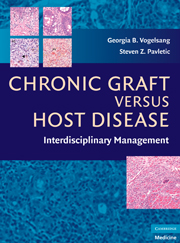Book contents
- Frontmatter
- Contents
- List of Contributors
- Preface
- PART I GENERAL PRINCIPLES
- PART II CLINICAL MANAGEMENT
- PART III ORGAN SITE OR SYSTEM-SPECIFIC MANIFESTATIONS
- PART IV SPECIAL CONSIDERATIONS IN CHRONIC GVHD
- 31 Design of Clinical Trials Testing Treatment for Chronic Graft versus Host Disease
- 32 Spectrum of Chronic Graft versus Host Disease in Unique Clinical Situations: The Role of Stem-Cell Source Including Cord Blood Stem Cells, Reduced-Intensity Conditioning, and Donor Leukocyte Infusions
- 33 Pediatric Chronic Graft versus Host Disease
- 34 Principles of Interdisciplinary Practice in the Care of Patients with Chronic Graft versus Host Disease
- 35 Patient Advocacy, Education and Psychosocial Support
- 36 Future Directions
- Index
- Plate section
33 - Pediatric Chronic Graft versus Host Disease
from PART IV - SPECIAL CONSIDERATIONS IN CHRONIC GVHD
Published online by Cambridge University Press: 26 August 2009
- Frontmatter
- Contents
- List of Contributors
- Preface
- PART I GENERAL PRINCIPLES
- PART II CLINICAL MANAGEMENT
- PART III ORGAN SITE OR SYSTEM-SPECIFIC MANIFESTATIONS
- PART IV SPECIAL CONSIDERATIONS IN CHRONIC GVHD
- 31 Design of Clinical Trials Testing Treatment for Chronic Graft versus Host Disease
- 32 Spectrum of Chronic Graft versus Host Disease in Unique Clinical Situations: The Role of Stem-Cell Source Including Cord Blood Stem Cells, Reduced-Intensity Conditioning, and Donor Leukocyte Infusions
- 33 Pediatric Chronic Graft versus Host Disease
- 34 Principles of Interdisciplinary Practice in the Care of Patients with Chronic Graft versus Host Disease
- 35 Patient Advocacy, Education and Psychosocial Support
- 36 Future Directions
- Index
- Plate section
Summary
INTRODUCTION
Allogeneic Transplantation in Pediatrics
Allogeneic hematopoietic stem cell transplantation (allo-HSCT) is curative for many pediatric diseases. Most children transplanted for cancer, severe combined immunodeficiency syndrome, aplastic anemia, sickle cell anemia, thalassemia, and certain metabolic disorders are expected to survive. This has led to an ever-increasing population of longterm survivors. Recent studies demonstrate the major impact that late effects have on the individual survivors and society as a whole.
Chronic Graft versus Host Disease
Chronic graft versus host disease (cGVHD) is the most significant nonrelapse cause of morbidity and mortality following stem cell transplantation (SCT) for malignancies. Although the rates of cGVHD are lower in children than adults, the incidence of cGVHD in children has increased in association with the use of peripheral blood and unrelated donors. The manifestations and mechanisms of cGVHD in children and adults appear similar, although the natural history and response to therapy are different. cGVHD and its current treatments have a spectrum of deleterious effects on normal growth and organ development in children. In addition, the impact of prolonged immunosuppression is of particular concern in childhood, a critical time of immunologic development in response to common infections and immunizations.
Data and research focused on cGVHD in pediatrics are limited. Most studies are small and are often grouped into larger adult series. In comparison to adults, relatively small numbers of children and adolescents undergo transplantation.
- Type
- Chapter
- Information
- Chronic Graft Versus Host DiseaseInterdisciplinary Management, pp. 369 - 385Publisher: Cambridge University PressPrint publication year: 2009
- 1
- Cited by

